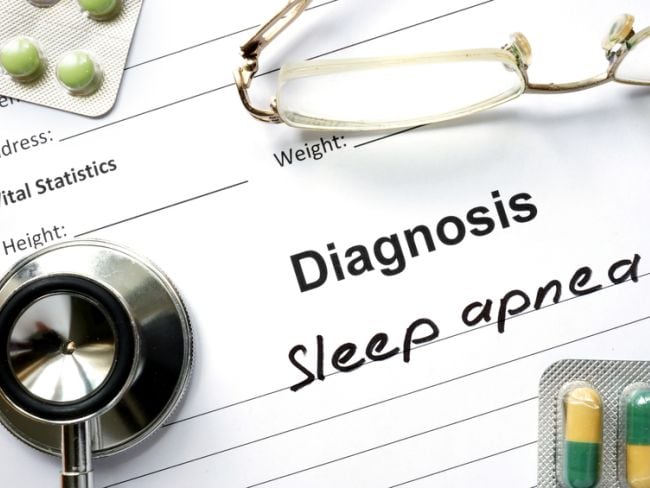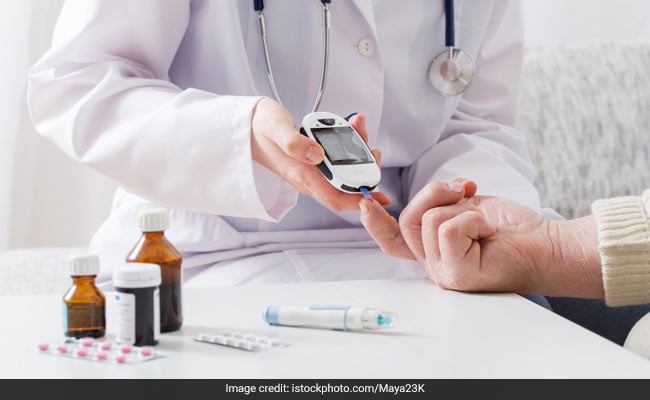Diabetes dis
Diabetes
What is it?
 Diabetes results in high levels of glucose in the blood
Diabetes results in high levels of glucose in the blood
Diabetes mellitus (DM) is the body's inability to regulate the level of glucose in the blood. Glucose is the main form of sugar in the body. The body breaks down food into glucose and uses it as a source of energy. In healthy people insulin helps to regulate the glucose (sugar) levels. Insulin is a hormone produced by the pancreas (a long, thin organ located behind the stomach against the back).
In diabetics, the body does not produce enough insulin or does not use the produced insulin effectively. This results in a high level of glucose in the blood ("hyperglycaemia").
There are three main types of diabetes mellitus:
a) Type 1, earlier known as insulin dependent diabetes mellitus (IDDM) or juvenile-onset diabetes mellitus. People with this type of diabetes make little or no insulin in their body, and need regular insulin injections for survival and management of diabetes. It usually starts in childhood, but can occur at any age. This ususally happen before age of 40.
b) Type 2 (DM2), earlier known as non-insulin dependent diabetes mellitus (NIDDM) or adult-onset diabetes. This is the most common form of diabetes, and is strongly associated with genetic tendency and obesity. The body produces normal or even high levels of insulin, but certain factors make its utilization ineffective ("insulin resistance"). Sedentary lifestyle, unhealthy dietary patterns, and the consequent obesity are common causes. It usually starts in adulthood, but is beginning to be seen in obese adolescents also.
c) Gestational diabetes mellitus, or pregnancy-induced diabetes.
Gestational diabetes is raised blood glucose levels during pregnancy. It develops in 5 % of all pregnancies but usually disappears when a pregnancy is over. Women who have had gestational diabetes are at increased risk (up to 40%) for later developing type 2 diabetes
What are the symptoms?
 Diabetes symptoms can vary from person to person
Diabetes symptoms can vary from person to person
Symptoms depend on the type and duration of diabetes. Some of the signs and symptoms are related to the high blood sugar levels.
These include: Increased urination, Increased thirst, Hunger
Other common symptoms:
- Fatigue
- Blurred vision
- Urinary and vaginal infections
- Skin infections, especially fungal or more serious bacterial infections
- Increased thirst
- Frequency of Urine
- Weight loss
- Genital itching or regular episodes UTI
- Slow healing of wounds
- Excessive hunger
There may be weight loss, especially if the amount of insulin made by the body is decreasing. If insulin deficiency is marked, the person can become drowsy and then go into coma. This is called Ketoacidosis, and usually occurs in DM1. Rarely, if the diabetes is completely out of control, it can also occur in DM2. Other symptoms of ketoacidosis include: Deep rapid breathing, sometimes with a fruity odour to the breath Pain in the stomach, with nausea and vomiting.
What are the risk factors?
- Indians Ethnicity
- Family history of DM
- BMI more than 23
- Overweight
- Waist is 80 inches in men over 90 inches for women.
- Sedentary lifestyle
- Impaired glucose tolerance
- Gestational diabetes.
How is the diagnosis made?
Diabetes mellitus is diagnosed based on a high level of glucose or sugar in the blood. The doctor may suspect diabetes mellitus after taking the medical history and doing a physical examination. There are several blood sugar tests used for diagnosis:
Fasting plasma glucose test: In this test, a person is asked to fast overnight, at least 8 hours, and the level of glucose in the blood is then checked. Normal fasting plasma glucose levels are less than 110 mg/dl. A fasting plasma glucose level of more than 126 mg/dl usually indicates diabetes mellitus. A level of 110-125 mg/dl is called "impaired fasting glucose".
Post prandial (PP) plasma glucose: This is tested two hours after having a meal, which serves as a challenge for the body to regulate the blood sugar. Normal PP levels are <140 mg/dl; a glucose level of more than 200 mg/dl indicates diabetes mellitus, while a level between 140-199 mg/ dl is called "impaired glucose tolerance".
Random plasma glucose test: is that which is done at any other time. A level of 200 mg/dl or higher generally indicates the presence of diabetes.
Oral glucose challenge test (oGTT): The blood glucose is tested 2 hours after giving 75 gm glucose by mouth. This is useful for detecting borderline diabetes and a condition called "impaired glucose tolerance".
Oral glucose tolerance test: is the preferred way to diagnose pregnancy-induced diabetes. Ideally all pregnant women in India should have a blood glucose test done 30 minutes after taking 50 gm gluocse (screening test). If this is abnormal, the lady should undergo an oGTT: with 100 gm glucose (not the conventional 75 gm). Blood samples are then drawn at intervals of one hour upto 3 hours (ie at 1, 2 and 3 hours post-glucose).
What is the treatment?
Although diabetes cannot be cured, it can be controlled very successfully. The main aim of treatment of all types of diabetes is to achieve blood glucose control, blood pressure and cholesterol levels as near to normal as possible. This, together with a healthy lifestyle, will help to improve wellbeing and protect against long-term complications.
Stay Active
Being active is good for all of us but is especially important for people with diabetes. Physical activity, combined with healthy eating and medication that you may taking will help you to manage your diabetes and prevent long term complications. If you have concerns at all about becoming active, never be afraid to ask for advice.
What are the Medication
People with diabetes often need additional treatment along with making lifestyle changes such as medication to control their Blood Pressure and blood fats. Treatment is decided by your specialist. But you should be aware of timings, dosage and its function in the body.
In diabetes stopping the treatment by your own can create lots of problems.
What are the complications?
Hypoglycemia is the common problem which can happen in pt who is being treated with oral medications or Insulin
Hypoglycemia (low blood sugar) can be life threatening condition and it’s very important to act early.
Low blood sugar: a level below about 60 milligrams per deciliter (mg/dl) — occurs when there's too much insulin and not enough sugar (glucose) in your blood. Low blood sugar is most common among people taking insulin, but it can also occur if you're taking oral diabetes medications.
When your blood sugar is low you may feel:
Shaky or nervous, Tired, Sweaty, Hungry, Irritable, Impatient, Cold, Confused
You may also feel tingling around your mouth.
Reasons for blood sugar swings
- In general, a blood sugar reading of more than 180 mg/dL or any reading above your target range is too high.
- A blood sugar reading of 300 mg/dL or more can be dangerous. If you have 2 readings in a row of 300 or more, call us
- Anything that can raise your blood sugar can cause it to go too high.
- Not having the:
- Right dose or kind of diabetes medicine,
- Being ill or stressed,
- forgetting to take your diabetes pills or insulin,
- Doing less exercise than usual, or
- Eating more carbohydrates than usual are all things that can cause your blood sugar to go too high.
Although it is frustrating, blood sugar levels can also be too high for no clear reason.
Sometimes these high levels may be the first sign of an infection, illness or stress.
Because blood sugar levels can go very high when you are ill, talk with your health care team about creating a „sick day plan‟ to manage your diabetes when you have a cold, flu or other illness.
What is the homecare treatment?
Pre Diabetes
Pre diabetes is when one has higher than normal glucose level but not high enough to be diagnosed with diabetes. Pre-diabetes is present when hba1c is over 6% -6.4%.
A person with pre-diabetes can be prevented to develop Diabetes by:
1. Improving diet
- Increase in consumption of foods high in fibre, such as whole grain and pulses, vegetables and fruits.
- Choose foods lower in fat and saturated fat like by replacing products high in saturated fat (such as butter, ghee,) with vegetable oils high in unsaturated fat or using low fat spreads.
- Choose skimmed or toned milk and products instead of cream and full fat milk.
- Choose lean meats instead of fatty meat and processed meat products.
- By changing cooking methods like opt for steaming, pressure cooking, boiling etc.
- Choose fruits, unsalted nuts or low fat snacks instead of cakes, biscuits, namkeens etc.
2. Increasing physical activity – at least 30 minutes for 5 days in a week.
3. By reducing body weight, high blood glucose levels can return to normal which reduces the likelihood of developing T2D.
Benefits of weight loss
- It reduces the risk of heart disease, diabetes and cancer.
- It decreases blood pressure, cholesterol.
- Decreases triglycerides and glucose in blood.
Benefits of an active lifestyle
- Burn calories.
- Preserves the body’s muscle and bone.
- Increases your metabolic rate.
- Helps appetite control.
- Improves health.
Maintaining a healthy weight and eating a healthy balanced diet, low in fat and rich in fiber and fruits and vegetables, as well as being physically active is an important part of managing blood sugar levels and avoiding other health complications.
Diabetes News More News
- Once-A-Week Insulin Treatment Could Be Highly Beneficial For Diabetes Patients: Study
- Heart Patients Three Times More Likely To Have Diabetes: Study
- Cholesterol Might Hold Key To New Therapies For Diabetes, Alzheimer's Disease
- Weekly Insulin Helps Patients With Type 2 Diabetes Achieve Similar Results To Daily Insulin
- Obesity Raises Type 2 Diabetes Risk In Women With PCOS, Says Study
- Type 2 Diabetes: Regular Exercise Can Be Effective For Prevention
- Overweight, Diabetic People At Risk Of Developing Non-Alcoholic Fatty Liver Disease
- More Than Half Of People In Their Twenties In Urban India Likely To Develop Diabetes In Lifetime: Study
- Diabetic Eye Disease Associated With High Risk Of Severe COVID-19, Finds Study
Diabetes Health Photos More Photos
Diabetes Videos More Videos
FAQ Related to Diabetes
- I am diabetic; can I take jaggery?
- What is the cause for high ESR?
- Is my diabetes due to insulin deficiency or insulin resistance?
- Why does my brother have low platelet count?
- Am I taking correct treatment for focal segmental glomerulosclerosis (FSGS)?
- What care should be taken by a pre-diabetic while planning a baby?
................... Advertisement ...................
................... Advertisement ...................
................... Advertisement ...................
................... Advertisement ...................
































